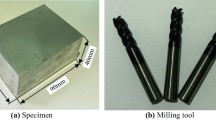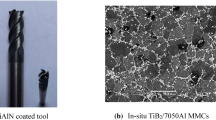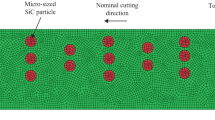Abstract
The surface roughness is one of the important parameters of surface quality evaluation. In the field of aerospace and industry, many attempts have been made to reduce the roughness of machined surface and improve the performance of parts. An advanced manufacture technique, ultrasonic vibration–assisted milling, can reduce the surface roughness, which is widely used to cut the materials that are difficult to machine. In this work, the theory of the machined surface generation is analyzed and the effect of cutting parameters and the ultrasonic vibration on the machined surface is investigated by ultrasonic vibration–assisted milling of in situ TiB2 particle–reinforced aluminum matrix composite. Firstly, the motion trajectory of cutting tool and machined surface topography generation is analyzed theoretically. Then, theoretical model of the number of vibration per cutting arc length and the transient angle is built to analyze the generation of the surface topography. Finally, experiments with and without ultrasonic vibration are carried out for the theoretical analysis of the machined surface generation and the surface roughness. The results show that regular micro-dimples are produced on the machined surface due to the addition of ultrasonic vibration and the theoretical model could be applied to explain the influence of ultrasonic vibration on the surface topography and roughness. Besides, in this study, the assistance of ultrasonic vibration can improve the surface quality in certain cutting conditions of cutting speed below 65.94 m/min and the vibration frequency of 20 kHz.









Similar content being viewed by others
References
Brezocnik M, Kovacic M, Ficko M (2004) Prediction of surface roughness with genetic programming. J Mater Process Technol 157:28–36
Sui H, Zhang XY, Zhang DY, Jiang XG, Wu RB (2017) Feasibility study of high-speed ultrasonic vibration cutting titanium alloy. J Mater Process Technol 247:111–120
Li SS, Wu YB, Nomura M (2016) Effect of grinding wheel ultrasonic vibration on chip formation in surface grinding of Inconel 718. Int J Adv Manuf Technol 86:1113–1125
Nestler A, Schubert A (2014) Surface properties in ultrasonic vibration assisted turning of particle reinforced aluminium matrix composites. Procedia CIRP 13:125–130
Lin KY, Wang WH, Jiang RS, Xiong YF (2019) Effect of tool nose radius and tool wear on residual stresses distribution while turning in situ TiB2/7050 Al metal matrix composites. Int J Adv Manuf Technol 100:143–151
Xiong YF, Wang WH, Jiang RS, Lin KY, Song GD (2016) Tool wear mechanisms for milling in situ TiB2 particle-reinforced Al matrix composites. Int J Adv Manuf Technol 86:3517–3526
Lin KY, Wang WH, Jiang RS, Xiong YF, Song GD (2017) Grindability and surface integrity of in situ TiB2 particle reinforced aluminum matrix composites. Int J Adv Manuf Technol 88:887–898
Xiong YF, Wang WH, Jiang RS, Lin KY (2018) Machinability of in situ TiB2 particle reinforced 7050Al matrix composites with TiAlN coating tool. Int J Adv Manuf Technol 97:3813–3825
Jiang RS, Wang WH, Song GD, Wang ZQ (2016) Experimental investigation on machinability of in situ formed TiB2 particles reinforced Al MMCs. J Manuf Process 23:249–257
Brehl DE, Dow TA (2008) Review of vibration-assisted machining. Precis Eng 32:153–172
Razavi H, Nategh MJ, Abdullah A (2012) Analytical modeling and experimental investigation of ultrasonic-vibration assisted oblique turning, part II: Dynamics analysis. Int J Mech Sci 63:12–25
Razavi H, Nategh MJ, Abdullah A (2012) Analytical modeling and experimental investigation of ultrasonic-vibration assisted oblique turning, part III: Experimental investigation. Int J Mech Sci 63:26–36
Dong GJ, Zhang HJ, Zhou M, Zhang YJ (2013) Experimental investigation on ultrasonic vibration-assisted turning of SiCp/Al composites. Mater Manuf Process 28:999–1002
Frank HK, Tawakoli T, Azarhoushang B (2017) Material removal mechanism in ultrasonic-assisted grinding of Al2O3 by single-grain scratch test. Int J Adv Manuf Technol 91:2949–2962
Zhou M, Wang M, Dong GJ (2016) Experimental investigation on rotary ultrasonic face grinding of SiCp/Al composites. Mater Manuf Process 31:673–678
Shen JY, Wang JQ, Jiang B, Xu XP (2015) Study on wear of diamond wheel in ultrasonic vibration-assisted grinding ceramic. Wear 332:788–793
Wei L, Zhang DZ (2019) Comparative study on drilling effect between conventional drilling and ultrasonic-assisted drilling of Ti-6Al-4 V/Al2024-T351 laminated material. Int J Adv Manuf Technol 103:141–152
Kadivar MA, Akbari J, Yousefi R, Rahi A, Nick MG (2014) Investigating the effects of vibration method on ultrasonic-assisted drilling of Al/SiCp metal matrix composites. Robot Cim-Int Manuf 30:344–350
Wang JJ, Feng PF, Zhang JF, Zhang CL, Pei ZJ (2016) Modeling the dependency of edge chipping size on the material properties and cutting force for rotary ultrasonic drilling of brittle materials. Int J Mach Tool Manu 101:18–27
Tao GC, Ma C, Bai LJ, Shen XH, Zhang JH (2017) Feed-direction ultrasonic vibration−assisted milling surface texture formation. Mater Manuf Process 32(2):193–198
Shen XH, Zhang JH, Xing DLX, Zhao YF (2012) A study of surface roughness variation in ultrasonic vibration-assisted milling. Int J Adv Manuf Technol 58:553–561
Zhu LD, Ni CB, Yang ZC, Liu CF (2019) Investigations of micro-textured surface generation mechanism and tribological properties in ultrasonic vibration-assisted milling of Ti-6Al-4V. Precis Eng 27:229–243
Ni CB, Zhu LD, Liu CF, Yang ZC (2018) Analytical modeling of tool-workpiece contact rate and experimental study in ultrasonic vibration-assisted milling of Ti-6Al-4 V. Int J Mech Sci 142:97–111
Chen G, Ren CZ, Zou YH, Qin XD, Lu LP, Li SP (2019) Mechanism for material removal in ultrasonic vibration helical milling of Ti-6Al-4 V alloy. Int J Mach Tool Manu 138:1–13
Zhang XQ, Kumar AS, Rahman M, Nath C, Liu K (2011) Experimental study on ultrasonic elliptical vibration cutting of hardened steel using PCD tools. J Mater Process Technol 211:1701–1709
Guo P, Ehmann KF (2013) An analysis of the surface generation mechanics of the elliptical vibration texturing process. Int J Mach Tool Manu 64:85–95
Liu JJ, Jiang XG, Han X, Gao Z, Zhang DY (2019) Effects of rotary ultrasonic elliptical machining for side milling on the surface integrity of Ti-6Al-4V. Int J Adv Manuf Technol 101:1451–1465
Tong JL, Wei G, Zhao L, Wang XL, Ma JJ (2019) Surface microstructure of titanium alloy thin-walled parts at ultrasonic vibration-assisted milling. Int J Adv Manuf Technol 101:1007–1021
Kurniawan R, Kiswanto G, Ko TJ (2017) Surface roughness of two-frequency elliptical vibration texturing (TFEVT) method for micro-dimple pattern process. Int J Mach Tool Manu 116:77–95
Verma GC, Pandey PM (2019) Machining forces in ultrasonic-vibration assisted end milling. Ultrasonics 94:350–363
Verma GC, Pandey PM, Dixit US (2018) Modeling of static machining force in axial ultrasonic-vibration assisted milling considering acoustic softening. Int J Mech Sci 136:1–16
Verma GC, Pandey PM, Dixit US (2019) An experimental study on surface roughness and frictional property of ultrasonic-vibration-assisted milled surface. P I Mech Eng C-J Mec 233(12):4187–4198
Maurotto A, Wickramarachchi CT (2016) Experimental investigations on effects of frequency in ultrasonically-assisted end-milling of AISI 316L: a feasibility study. Ultrasonics 65:113–120
Xiong YF, Wang WH, Jiang RS, Lin KY (2017) A study on cutting force of machining in situ TiB2 particle-reinforced 7050Al alloy matrix composites. Metals 197(7):2–14
Dong WP, Sullivan PJ, Stout KJ (1994) Comprehensive study of parameters for characterising three dimensional surface topography III: parameters for characterising amplitude and some functional properties. Wear 178:29–43
Funding
This work is sponsored by the National Science and Technology Major Project (Grant No. 2017-VII-0015-0111), National Natural Science Foundation of China (Grant No. 51775443), and Innovation Foundation for Doctor Dissertation of Northwestern Polytechnical University (Grant No. CX201829).
Author information
Authors and Affiliations
Corresponding author
Additional information
Publisher’s note
Springer Nature remains neutral with regard to jurisdictional claims in published maps and institutional affiliations.
Rights and permissions
About this article
Cite this article
Liu, X., Wang, W., Jiang, R. et al. Investigation on surface roughness in axial ultrasonic vibration–assisted milling of in situ TiB2/7050Al MMCs. Int J Adv Manuf Technol 111, 63–75 (2020). https://doi.org/10.1007/s00170-020-06081-4
Received:
Accepted:
Published:
Issue Date:
DOI: https://doi.org/10.1007/s00170-020-06081-4




